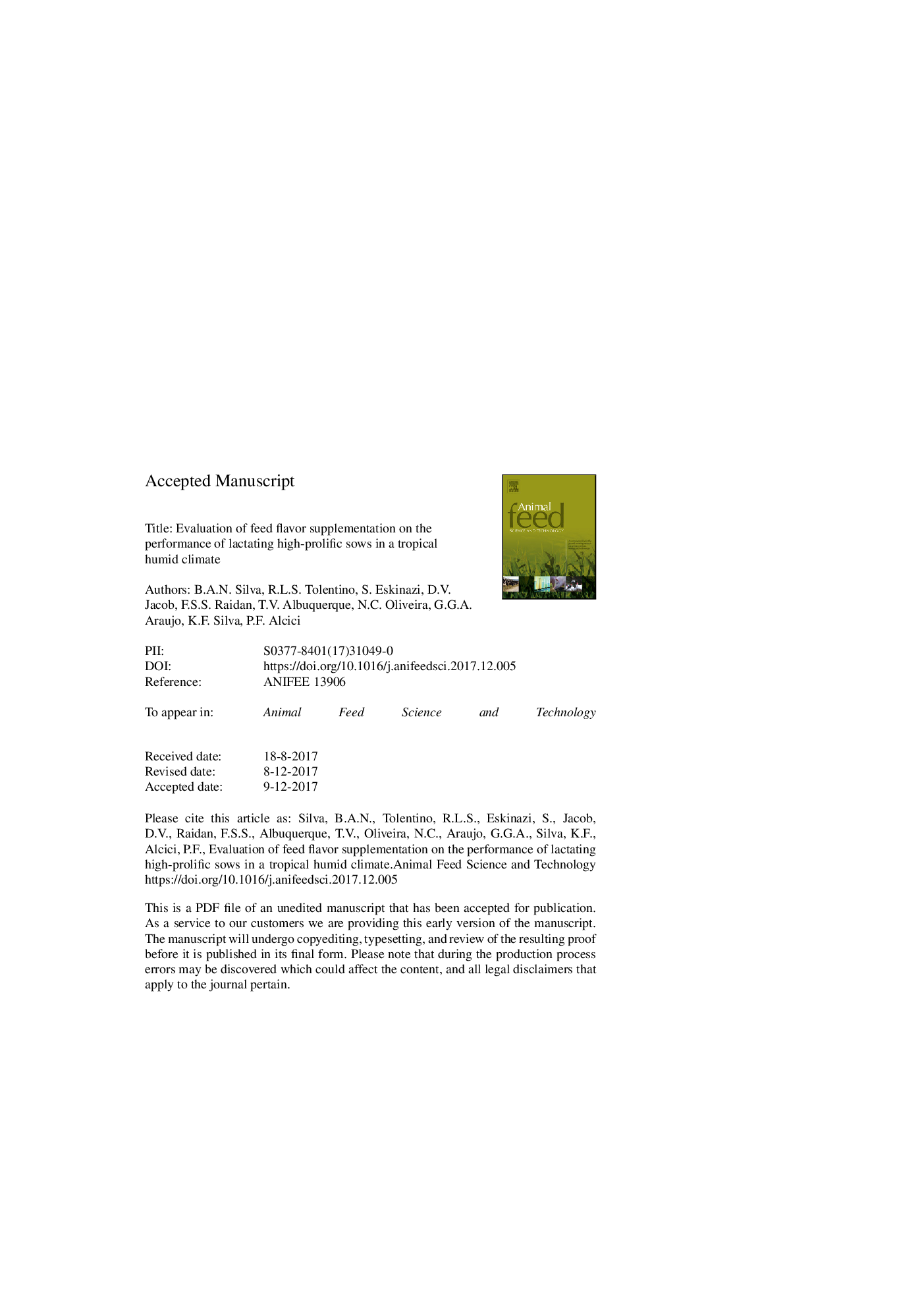| کد مقاله | کد نشریه | سال انتشار | مقاله انگلیسی | نسخه تمام متن |
|---|---|---|---|---|
| 8491057 | 1552350 | 2018 | 28 صفحه PDF | دانلود رایگان |
عنوان انگلیسی مقاله ISI
Evaluation of feed flavor supplementation on the performance of lactating high-prolific sows in a tropical humid climate
ترجمه فارسی عنوان
ارزیابی مکمل فساد خوراکی بر عملکرد شیردهی پر تحرک در محیط آب و هوایی مرطوب گرمسیری
دانلود مقاله + سفارش ترجمه
دانلود مقاله ISI انگلیسی
رایگان برای ایرانیان
کلمات کلیدی
طعم غذا، استرس گرما، شیردهی، تولید شیر، سواری،
موضوعات مرتبط
علوم زیستی و بیوفناوری
علوم کشاورزی و بیولوژیک
علوم دامی و جانورشناسی
چکیده انگلیسی
Three hundred mixed parity sows of a high prolificacy genetic line were used to evaluate the impact of the supplementation of different levels of feed flavor during lactation on their productive and reproductive performance under tropical conditions. Sows were distributed in a completely randomized experimental design among 3 dietary treatments: control diet (T1) and other two diets with different levels of inclusion (T2â¯=â¯250 and T3â¯=â¯500â¯g/ton) of a feed flavor during 24 d lactation and WEI. The average minimum and maximum ambient temperatures and daily relative humidity measured during the experimental period were 17.4 and 34.7â¯Â°C, and 38.0% and 93.8%, respectively. The treatments influenced (Pâ¯<â¯0.001) the sows voluntary feed intake, the T3 sows showed a higher intake than T2 and higher than T1 (6.60 vs. 6.02 vs. 5.08â¯kg/d, respectively). When compared among sows fed the feed flavor, the higher level of inclusion (T3) showed a +9.6% higher (Pâ¯<â¯0.001) feed intake than T2 sows. The sows from T3 showed a higher (Pâ¯=â¯0.039) number of weaned piglets when compared to T2 and higher than T1 (13.45 vs. 13.07 vs. 12.95, respectively). There was an effect of the treatment (Pâ¯<â¯0.001) on litter daily gain where litters from T3 sows showed a higher daily gain when compared to T2 and T1 (3.37 vs. 2.75 vs. 2.58â¯kg/d, respectively). Average weaning weight was also higher (Pâ¯<â¯0.001) for piglets from T3 sows when compared to T2 and T1 (7.00 vs. 6.16 vs. 5.86â¯kg, respectively). Average daily milk production was higher (Pâ¯<â¯0.001) in the T3 sows when compared with the T2 and T1 fed sows (12.99 vs. 9.55 vs. 8.59â¯kg/d, respectively). The weaning-to-oestrus interval did not differ among treatments and averaged 4.3 d (Pâ¯>â¯0.10). Respiratory frequency was influenced (Pâ¯=â¯0.027) by treatments, whereas T3 sows showed on average a higher respiratory rate when compared with T2 and T1 (82.7 vs. 79.6 vs. 65.4 movements/min, respectively). The treatments influenced (Pâ¯<â¯0.001) the rectal temperatures, where on average T1 sows showed lower values when compared to T2 and T3 fed sows (38.8 vs. 39.1 vs. 39.3 °C, respectively). In conclusion, this experiment has demonstrated that the strategic use of feed flavor to stimulate sows voluntary feed intake can benefit milk production and as a consequence improve litter performance all of which can help attenuate the negative effects of heat stress conditions on the nursing sow.
ناشر
Database: Elsevier - ScienceDirect (ساینس دایرکت)
Journal: Animal Feed Science and Technology - Volume 236, February 2018, Pages 141-148
Journal: Animal Feed Science and Technology - Volume 236, February 2018, Pages 141-148
نویسندگان
B.A.N. Silva, R.L.S. Tolentino, S. Eskinazi, D.V. Jacob, F.S.S. Raidan, T.V. Albuquerque, N.C. Oliveira, G.G.A. Araujo, K.F. Silva, P.F. Alcici,
